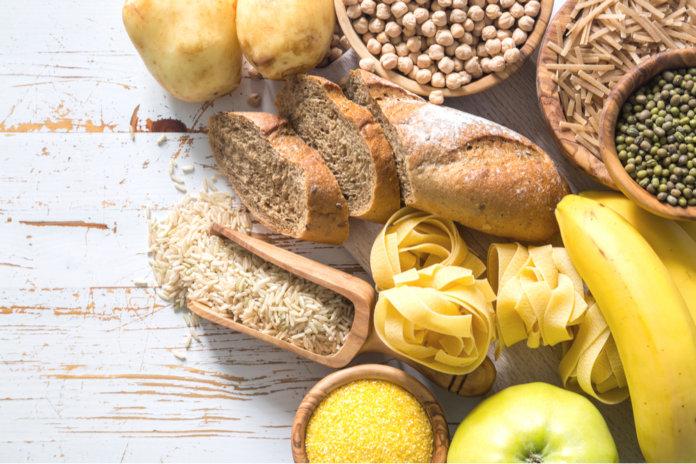Gorging on bread and pasta during the days leading to an endurance sports event is common practice. Known as carb-loading, this is a nutritional tool intended for elite athletes but practiced by many.
In fact, many Americans inadvertently and unnecessarily carb loads nearly every day. On the contrary, carb loading can pose its own risks and may not be as necessary as once believed.
Alas, this article serves as a comprehensive guide to carb-loading debunked.
What Is Carb Loading?
Carb loading refers to a nutritional strategy that aims to increase the amount of stored glycogen within the body above normal levels. It customarily involves eating abnormally high amounts of carbohydrates for several days while simultaneously tapering endurance exercise to decrease the utilization of carbs for fuel.
The Food and Drug Administration (FDA) recommends a Daily Value (DV) of about 300 grams per day based on a 2,000 kcal diet. However, carb-loading may entail eating upwards of 650 grams per day.
Conventionally, this strategy is utilized before athletic events or competitions because carbs are the main fuel source for exercise.
The thought is that optimizing glycogen, the stored form of glucose in muscles and liver, beyond normal levels will extend one’s capacity to perform in an endurance athletic event. While research shows that carb loading can reduce fatigue and improve endurance performance by 2 to 3 percent if the event is longer than 90 minutes, it holds little promise if the event is shorter than that.
Additionally, it is likely ineffective for exercise that involves short bursts of activity like sprinting, recreational sports, and strength training even if total activity time reaches the 90-minute mark.
Different Versions of Carb Loading
Like any nutritional strategy, carb loading is not a “one size fits all” and different variations of this tool exist. Nonetheless, all forms involve increasing carbohydrate consumption and temporarily decreasing exercise.
All are also intended to be applied short-term in the days leading up to an endurance athletic event.
The Classic 6-Day
Beginning six days before the main competition, the first three days of this version involve consuming a maximum of 15 percent carbohydrate diet and exercising normally or according to an individualized plan to decrease the body’s glycogen stores. The next three days entail eating 70 percent of total daily calories from carbs while greatly reducing exercise, if performing any at all.
Newer research shows that complete depletion of glycogen stores is not necessary as once believed.
Unconventional 6-Day
Basically a moderate version of the above method, this program recommends eating a diet of 50 percent carbohydrate for the first three days followed by a diet of 70 percent carbohydrate for the remaining three days.
Throughout the six days, exercise is reduced so that on days 4 to 6. One only performs a maximum of 20 minutes, although none is required.
The Classic 3-Day
A very simple method, this carb-loading version involves performing an exercise session to exhaustion three days before the intended competition. Exercise is halted thereafter while obtaining 70 percent of calories from carbohydrates.
Modified 3-Day
This version is identical to the classic 3-day method, minus the exhaustive exercise session at the beginning of day three.
When researchers studied this method in practice, they determined a carbohydrate intake of 4.5 grams per pound of body weight per day was sufficient. For a 154-pound person, this would equate to 700 grams of carbs per day!
The 1-Day
The simplest version of them all, this type of carbo-loading involves abstaining from exercise for one full day. One consumes 4.5 grams per pound of carbohydrate (10 grams per kg body weight) per day.
The Science Behind Carbohydrate Loading
It is estimated that the average healthy person can store about 1,600 to 2,500 calories of glycogen within the muscles and liver at any point in time. This amount is more than sufficient to fuel 90 minutes of vigorous endurance activity, hence why carb loading is moot for activity shorter than this duration.
Still, how did carb-loading become so popular? The answer resides within carbohydrate and fat metabolism.
Once the performing body uses all its glycogen stores, it shifts to burning fat as fuel. This sounds great in theory, and would be for a person trying to lose weight, but it is quite taxing and can therefore deter endurance exercise performance. Fat metabolism, or the breakdown of fat, requires ample oxygen and these increased demands can cause the all-too-typical feeling of hitting the wall during an endurance event.
Thus, carb loading can help stave off the dreaded bonk by increasing muscular and neural stamina. Of note, the practice may be more important and beneficial for certain events because carbs are metabolized more rapidly at altitude and in hot weather.
However, carb loading is contraindicated for certain populations like those with diabetes and those who frequently suffer from GI distress during exercise. In these cases, eating sufficient amounts of carbs during exercise performance can help prevent tanking.
Still, as mentioned, carb loading is not void of potential risks and complications.
Risks of Carb Loading
Why carb loading is not bad per se, it does come with risks.
Eating Too Many Calories
Given permission to eat all the carbs, it is all too easy to overconsume total calories as well. After all, many high-carb foods are also high in calories.
However, the objective is to increase total carbohydrate intake (to about 70 percent) proportionally to the current total daily caloric intake. Typically, this results in consuming an optimal remainder of 15 to 20 percent protein and 10 to 15 percent fat.
Gaining Weight
While scientifically impossible to gain a significant amount of fat in a mere few days, carb loading can certainly make it feel like so.
Not only do carbs retain water (about 2 to 3 grams per gram of carb) which increases the number reflected on the scale, large amounts can leave one feeling bloated, lethargic, inflamed, puffy, and heavy. All of these effects could hinder endurance performance.
Eating Too Much Fat
Eating fat does not make one “fat”, but eating too much of it is a potential pitfall. Many high-carb foods like chips, crackers, cookies, snack cakes, and other pastries typically eaten during a carb load are equally high in fat.
Essentially, this combo results in overconsumption of calories, which ultimately directs energy and resources towards digestion and storage of nutrients rather than the efficient breakdown of nutrient stores to fuel exercise and athletic performance.
Consuming Too Much Fiber
Eating the recommended 20-25 grams and 30-38 grams of fiber for women and men, respectively, is an admirable feat. However, eating much more than that during the days leading up to the endurance event can cause GI distress.
Depending on the ratio of soluble to insoluble fiber, one might suffer gas, bloating, constipation, diarrhea, nausea, and a slew of other symptoms. This is one instance to swap the whole grains for white products, but more importantly, do not do anything drastically different from normal if it has not been previously tested (i.e. before a long training run, etc.).
Experiencing GI Distress
Finally, as a natural consequence of any of the above, one can experience GI distress due to carb loading. Whether the distress is related to eating too many overall calories or too much fiber, it is unpleasant and inconvenient. Learn how to minimize this risk by avoiding carb-loading myths in the next section!
How to Correctly Carb Load
If carb loading is a beneficial nutritional strategy for an upcoming endurance event, apply the following techniques to implement it correctly.
1. Count Carbs
Monitoring daily carb amounts helps to ensure accuracy and makes the endeavor fruitful. Using a food tracking application like MyFitnessPal is the best way to track daily intake.
Before monitoring intake, calculate the carb goal by multiplying your weight in pounds by 2.3 to 5.5 depending on individual goals. However, some sports nutrition experts recommend a more stringent range of 3.6 to 4.5 grams per pound of body weight.
2. Avoid Highly Refined Sugar
It’s prudent to limit refined sugar on a regular basis, but doing so before a major competition can reduce inflammation and optimize cellular health, which translates into better performance. Remember, not all carbs are created equal.
Focus on eating high-quality carbs like regular and sweet potatoes, jasmine rice, quinoa, sourdough bread, bananas, and easy-to-digest veggies like carrots, bell peppers, iceberg lettuce, onions, and squash and limit products like cookies and cakes.
3. Consume Around the Same Amount of Overall Calories Daily
As mentioned above, eating too many calories can be detrimental. Therefore, it is important to focus on increasing carbs in proportion to the amount of calories you are already consuming. Typically, this will result in eating less protein and fat.
4. Limit High-Fat Foods
Most bodies contain sufficient amounts of fat stores that they can utilize if glycogen stores deplete during performance. Thus, it is unnecessary to load up on fat before a competition.
Plus, fat, especially when derived from foods also high in refined sugar, inflammatory oils, and saturated fat can make someone feel bogged down, puffy and fatigued because the body’s resources are being used towards digestion. High-fat diets can also cause GI distress like diarrhea during performance.
5. Be Aware of High-Fiber Foods
While unnecessary to completely avoid fiber during the days before the performance, it is sensible to be aware of consumption. Rather than trying to hit a certain goal, try to consume around the same amount as you already do. In fact, doing anything out of the ordinary during the few days before a competition is never a good idea!
Most importantly, do not utilize carb loading as a nutritional tool often. Doing so, such as before every 5k race or strength training session, will reduce its effectiveness before athletic events it could truly benefit like half and full marathons, ironmans, and long endurance swimming or cycling competitions.
What’s more, research shows that unnecessarily employing this nutritional strategy can actually decrease exercise performance, which is the exact opposite of intentions!
The Takeaway
Carb loading is a nutritional strategy that involves consuming larger than normal amounts of carbohydrates during one to six days leading up to an athletic endurance event. While this strategy can slightly improve exercise performance by reducing time to fatigue during endurance events longer than 90 minutes, it is largely ineffective for shorter events or those that involve short bursts of activity.
Nonetheless, eating abnormally large amounts of carbohydrates poses some risks like weight gain and GI distress among others, and is not helpful for everyone, though is especially encouraged for events taking place at altitude or in hot environments.
Finally, applying correct carb-loading techniques by eating the right amount and types of carbohydrates can mean the difference between a four or five-hour marathon. Try out the different versions to see which one fuels that personal record!
References:
Fetters A. 5 Must-Know Myths About Carb-Loading. mapmyrun. Published November 1, 2017. blog.mapmyrun.com/5-must-know-myths-carb-loading/.
Gunnars K. How Many Carbs Should You Eat per Day to Lose Weight? Healthline. Published April 2, 2020. www.healthline.com/nutrition/how-many-carbs-per-day-to-lose-weight.
Roy K. Debunking the Carb Loading Myth. Fly Feet Running. www.flyfeetrunning.com/rundown/debunking-the-carb-loading-myth.
Tinsley G. Carb Loading: How to Do It + Common Mistakes. Healthline. Updated February 11, 2018. www.healthline.com/nutrition/carb-loading.
Yawitz K. The Myths and Facts Behind Carb Loading. Terrain Magazine. Published March 6, 2018. terrain-mag.com/the-myths-and-facts-behind-carb-loading/.









